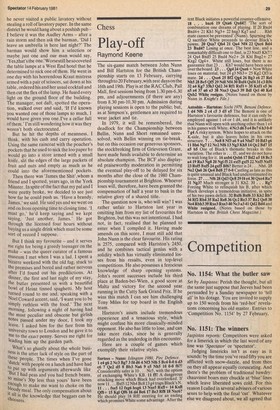Play-off
Raymond Keene
The six-game match between John Nunn and Bill Hartston for the British Championship starts on 13 February, carrying throughto 20 February ,with rest dayson the 16th and 19th. Play is at the RAC Club, Pall Mall, first sessions being from 1.30 pm-6.30 pm, and adjournments (if there are any) from 8.30 pm-10.30 pm. Admission during playing sessions is open to the public; but, as at Simpson's, gentlemen are required to wear jacket and tie.
In 1979, it will be remembered, the deadlock for the Championship between Bellin. Nunn and Short remained unresolved, with Bellin winning on tie-break, but on this occasion our generous sponsors, the stockbroking firm of Grieveson Grant, have made funds available to determine an absolute champion. The BCF also displayed praiseworthy moderation in permitting the eventual play-off to be delayed for six months after the close of the 1980 Championship tournament at Brighton. Whoever loses will, therefore, have been granted the compensation of half a year to bask in the relative glory of a shared title.
The question now is, who will win? I was rather unfair to Hartston last year in omitting him from my list of favourites for Brighton, but this was not intentional. I had not, in fact, realised that he planned to enter when I compiled it. Having made amends on this score, I must still add that John Nunn is the clear favourite. His rating is 2575, compared with Hartston's 2450, and he combines tactical genius with a solidity which has virtually eliminated losses from his results, even in top-level competitions. He also possesses a ferocious knowledge of sharp opening systems. John's recent successes include his third place at Baden-bei-Wien, a good score at Malta and victory for the second year running in the Cutty Sark Grand Prix. If he wins this match I can see him challenging Tony Miles for top board in the English team.
Hartston's assets include tremendous experience and a tenacious style, which might confuse his more classically-minded opponent. He also has little to lose, and can take more risks, since he is generally regarded as the underdog in this encounter. Here are a couple of games which exemplify their relative styles.
Surtees — Nunn: Islington 1980, Pirc Defence. 1 e4 g6 2 Nc3 Bg7 314 d6 4 Nf3 Nf6 S Bc4 0-06 d3 c6 7 Qe2 d5 8 Bb3 Na6 9 e5 Nh5 10 0-0 16?! Considerably safer is 10. . Nc5, with the option of exchanging White's KB. ii rs: A dangerous attacking move which Black had overlooked. If now 11 . . . Bxf5 12 Nh4 Bc8 13 g4 traps Black's N. 11 • . . fxeS 12 fxg6 hxg6 13 Nxe5 Rx11+ 14 KO Qf8+ 15 Kgl Q16 16 d4 0e6 17 Be3 RIB 18 Nxr6? He should play 18 Rfl steering for an ending which promises White some advantage. After the text Black initiates a powerful counter-offensive. 18 . . . bxc6 19 Qxa6 Qxd4!! 'The sort of combination one dreams of playing. If 20 Bxd4 Bxd4+ 21 Khl Ng3+ 22 hxg3 Kg7 and . . . Rh8 mate cannot be prevented' (Nunn). Spurning the Q sacrifice White proceeds to devour Black's pawns. 20 Qxa7 Qh4 21 Qa4 N14 22 Qxc6 Bd4
23 itxd4? Losing at once. The best line, and a remarkably difficult one to find, is 23 Nxd5 Kh7!!
24 Qa4 Bxd5 25 Bxd4 Ne2+ 26 Khl Bxg2+ 27 Kxg2 Qg4+ . White still loses, but there is no guarantee that 23. . . Kh7 Would have been seen over the board. 23. . . Qg4 24 Qxe6 + Now White loses on material, but 24 g3 Nh3+ 25 Kg2 0f3 is mate. 24. . . Qxe6 25 1912 Qg4 26 Bg3 e6 27 Rel Nh5 28 Be5 Qf5 29 Ndl Nf4 30 Bxf4 Qxf4 31 c3 Rf6 32 a4 Kg7 33h3 Qd2 34 an Rxfl + 35 Kxfl e5 36 a5 e4 37 a6 e3 38 Nxe3 Qxe3 39 Bdi Qc1 40 Kel Qxb2 Whitc resigns. (Notes based on those by Nunn in Knight's File.) Antoshin — Hartston: Sochi 1979, Benoni Defence. 1 d4 N16 2 c4 c5 3 d5 e5 The Benoni is one of Hartston's favourite defences, but it can only be employed against 1 c4 or 1 d4, and it is unlikely that Nunn will open with anything other than 1 e4 in his games with White. 4 Nc3 d6 S e4 Be7 6 h3 0-0 7 g4 A risky system. White hopes to attack on the K-side, but it also leaves holes in his own structure. 7... Ne8 8 Nf3 a6 9 a4 Nbd7 10 Bd3 g6 11 Bh6 Ng7 12 Ne2 N16 13 Ng3 Kh8 14 Qc2 Bd7 15 a5 b5 One of Black's thematic breaks in this variation. The other is. . . 15, and we do not have to wait long for it. 16 axb6 Qxh6 17 Bd2 a5 18 Bc3 a4 19 Ra3 Ng8 20 Ng, 15 21 exf5 gxf5 22 Nxf5 Nxf5 23 Bxf5 Bxf5 24 gxf5 Bf6? Better is 24 . Nh6. 25 Ne2 Qa6 26 Qe4 Bd8 270-0 Castling as late as this is quite unusual and Black had underestimated its force. 27 ... Nf6 28 Qd3 Qc8 29 14 e4 30 Qxe4 Ra7 31 Ng3? Much stronger is 31 Kh2. 31 . . . Rg7 Forcing White to relinquish his B, after which Black develops a tremendous initiative, in spite of his two pawn deficit. 32 Bxf6 Bxf6 33 Kh2 Rh7 34 R12 Rb4 35 Ra2 Re8 36 Qc2 Re3 37 Re2 Qe8 38 Ne4 Rbb3 39 Rxe3 Rxe3 40 Nc3 a3 41 Qd2 0d4 and White resigned. (Notes based on those by Hartston in the British Chess Magazine.)






































 Previous page
Previous page